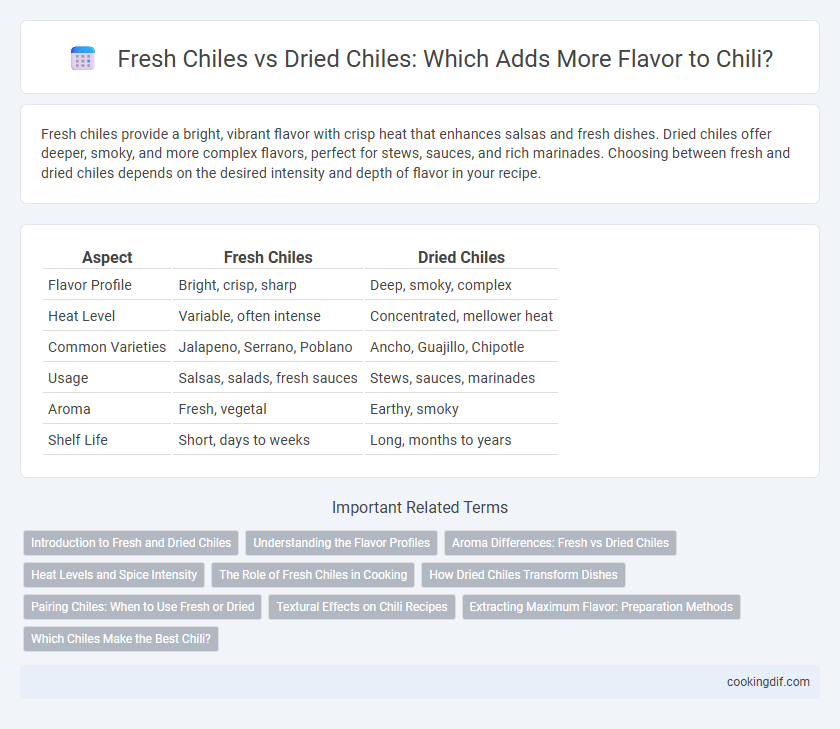Fresh chiles provide a bright, vibrant flavor with crisp heat that enhances salsas and fresh dishes. Dried chiles offer deeper, smoky, and more complex flavors, perfect for stews, sauces, and rich marinades. Choosing between fresh and dried chiles depends on the desired intensity and depth of flavor in your recipe.
Table of Comparison
| Aspect | Fresh Chiles | Dried Chiles |
|---|---|---|
| Flavor Profile | Bright, crisp, sharp | Deep, smoky, complex |
| Heat Level | Variable, often intense | Concentrated, mellower heat |
| Common Varieties | Jalapeno, Serrano, Poblano | Ancho, Guajillo, Chipotle |
| Usage | Salsas, salads, fresh sauces | Stews, sauces, marinades |
| Aroma | Fresh, vegetal | Earthy, smoky |
| Shelf Life | Short, days to weeks | Long, months to years |
Introduction to Fresh and Dried Chiles
Fresh chiles offer vibrant, bright flavors with a crisp texture and a sharp heat that enhances salsas, salads, and stir-fries. Dried chiles provide deep, smoky, and complex flavors essential in traditional Mexican moles, sauces, and slow-cooked dishes. The choice between fresh and dried chiles depends on the desired flavor intensity and culinary application in authentic chili recipes.
Understanding the Flavor Profiles
Fresh chiles offer bright, crisp, and slightly sweet flavors with a refreshing heat that enhances dishes with vibrant complexity. Dried chiles concentrate smoky, earthy, and rich savory notes, intensifying depth and warmth in recipes. Understanding these distinct flavor profiles helps chefs balance heat and enhance overall taste in authentic Mexican cuisine.
Aroma Differences: Fresh vs Dried Chiles
Fresh chiles offer a vibrant, bright aroma with herbal and grassy notes that enhance dishes with a lively, crisp scent. Dried chiles concentrate smokiness, earthiness, and deep, complex flavors due to the drying process, which intensifies their aromatic profile. The choice between fresh and dried chiles dramatically influences the aroma complexity and flavor depth in culinary applications.
Heat Levels and Spice Intensity
Fresh chiles provide a vibrant, bright heat with a crisp, vegetal flavor profile, delivering moderate spice intensity that intensifies when cooked. Dried chiles offer concentrated heat and deeper, smokier spice notes due to the drying process, often resulting in stronger and more complex heat levels. Choosing between fresh and dried chiles depends on the desired balance of heat intensity and flavor depth in recipes.
The Role of Fresh Chiles in Cooking
Fresh chiles provide vibrant, bright flavors with a crisp texture, contributing essential heat and herbal notes to dishes. Their high moisture content enhances sauces and salsas by adding a lively, tangy freshness that dried chiles can't replicate. Using fresh chiles in cooking allows for precise control over spice levels and a clean, bold chili taste ideal for ceviches, salads, and stir-fries.
How Dried Chiles Transform Dishes
Dried chiles concentrate and deepen flavor profiles, offering smoky, earthy, and complex notes that fresh chiles cannot. Their intense heat mellows as they rehydrate, imparting rich umami and subtle sweetness to sauces, stews, and marinades. Incorporating dried chiles like ancho, guajillo, or chipotle transforms dishes by layering robust, nuanced taste and enhancing overall depth.
Pairing Chiles: When to Use Fresh or Dried
Fresh chiles offer bright, crisp flavors that enhance dishes requiring vibrant heat and a herbaceous note, ideal for salsas, salads, and stir-fries. Dried chiles provide deeper, smoky, and complex flavor profiles suited for slow-cooked stews, sauces like mole, and rich marinades. Pair fresh chiles with light, fresh ingredients to preserve their tang, while dried chiles integrate well into hearty recipes where their robust flavors develop over time.
Textural Effects on Chili Recipes
Fresh chiles offer a crisp, juicy texture that enhances the vibrancy and moisture in chili recipes, contributing to a lively mouthfeel. Dried chiles provide a denser, chewier consistency, infusing deep, concentrated flavors and a slightly smoky undertone that develops during rehydration and cooking. The choice between fresh and dried chiles directly impacts the chili's texture, balancing moisture and firmness to achieve the desired textural complexity.
Extracting Maximum Flavor: Preparation Methods
Fresh chiles deliver vibrant, bright flavors with a crisp texture that enhances salsas and fresh dishes, while dried chiles offer deeper, complex smoky and earthy notes essential for rich sauces and stews. To extract maximum flavor, fresh chiles should be roasted or charred lightly to release oils and intensify heat, whereas dried chiles benefit from soaking in hot water to rehydrate and unlock their full aroma before blending. Proper preparation methods tailored to each form ensure optimal flavor extraction, elevating traditional chili recipes and creating balanced, flavorful dishes.
Which Chiles Make the Best Chili?
Fresh chiles, such as jalapenos and serranos, deliver bright, vibrant heat and a grassy, crisp flavor ideal for adding depth to chili dishes. Dried chiles like ancho, guajillo, and chipotle provide smoky, complex, and earthy notes that create rich, layered chili profiles. Combining both fresh and dried chiles often yields the best chili, balancing freshness with robust, smoky undertones.
Fresh Chiles vs Dried Chiles for flavor Infographic

 cookingdif.com
cookingdif.com